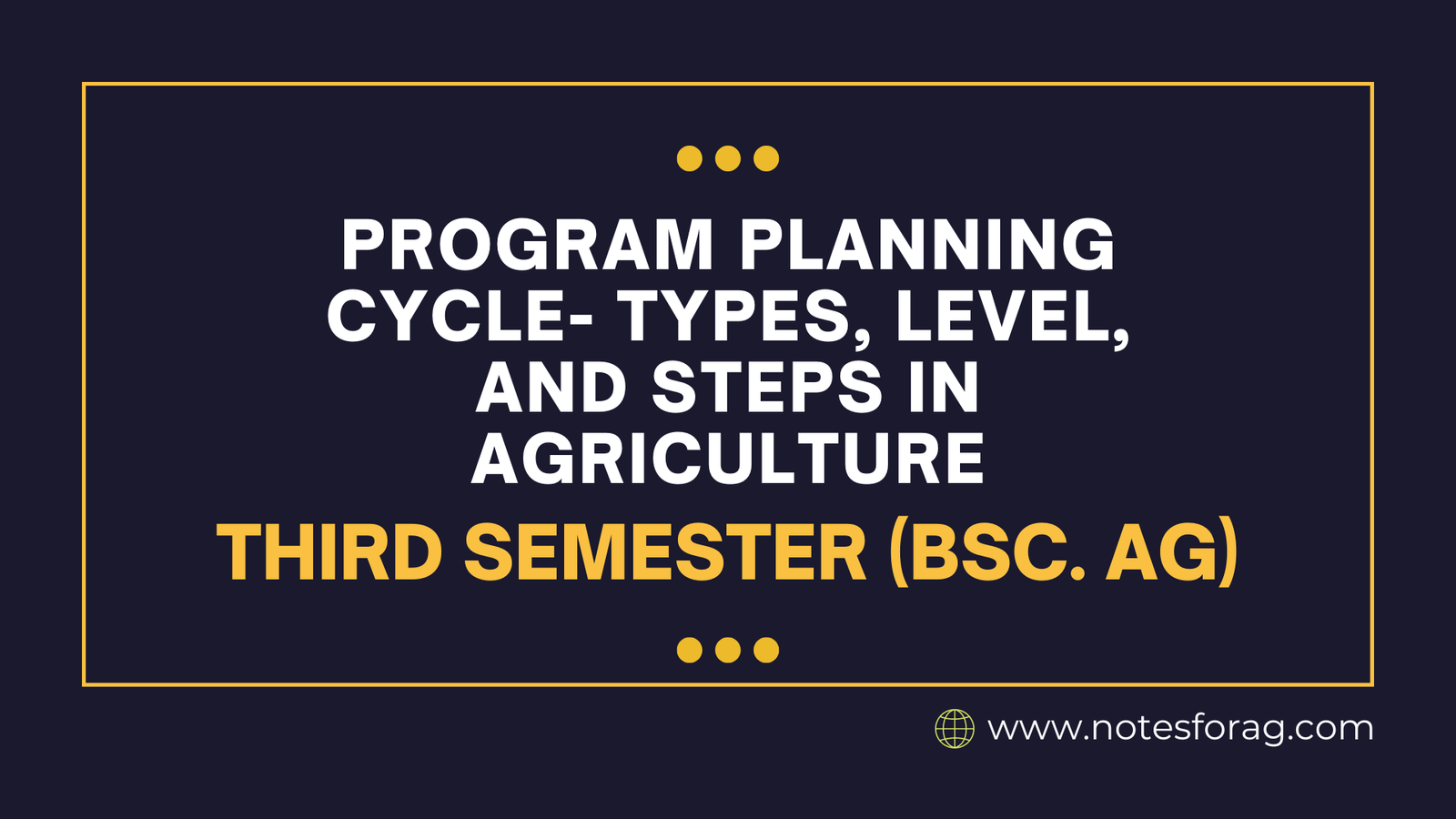Agriculture program planning cycle is a systematic strategy to meeting the needs of farmers and rural communities. It employs a variety of planning methods, including top-down, bottom-up, and participatory techniques, and operates at multiple levels, ranging from national to municipal to individual farms. The program planning cycle consists of several essential steps: needs assessment, problem identification, goal setting, program design, resource allocation, implementation, monitoring, evaluation, and adjustment. This method guarantees that agricultural initiatives are relevant, efficient, and effective in promoting sustainable agricultural development.
Table of Contents
Introduction to the Program Planning Cycle in Agriculture
The agricultural program planning cycle is a systematic process that is required to ensure effective agricultural development and productivity. This program planning cycle consists of a set of interconnected processes that take stakeholders from the initial assessment of needs to the evaluation of outcomes. A structured program planning process can help agricultural programs improve their efficiency, match aims with community needs, and encourage sustainability.
The significance of program planning stems from its potential to promote higher agricultural output while addressing critical challenges such as resource management, environmental sustainability, and community development. Effective planning allows agricultural organizations and farmers to deploy resources wisely, apply novel practices, and assess results against predetermined goals.
Types of Program Planning in Agriculture
Program planning in agriculture encompasses various specialized approaches designed to enhance productivity and efficiency within the sector.
- Top-down planning: Higher-level authorities, such as government agencies or organizations, make decisions and plans, which are then implemented at the grassroots level. This technique may not involve local communities, yet it can be effective in delivering large-scale programs rapidly.
- Bottom-up Planning: Farmers, community residents, and local officials all participate directly. The community recognizes its own requirements, and programs are designed to meet those needs. This strategy ensures better relevance and local ownership, however it may take longer to implement.
- Participatory Planning: A blend of top-down and bottom-up approaches in which external specialists and local communities work together. This hybrid strategy aims to strike a balance between large-scale direction and local input, ensuring that initiatives are both effective and community-focused.
Levels of Program Planning in Agriculture
- National Level: At this level, agricultural policies and initiatives aim to address broad challenges such as food security, agricultural innovation, and national productivity. Typically, this is handled by the government, ministries, and national agencies.
- Regional/provincial Level: This level focuses on meeting agricultural demands unique to specific areas or provinces. Programs can be tailored to the region’s unique climate, crops, and economic situations.
- Local/Community Level: At this level, program planning prioritizes direct involvement with farmers and local leaders. It focuses on the specific issues and opportunities faced by farmers, such as pest control, crop selection, and water management.
- Individual / Farm Level: Planning is centered on farmers’ specific needs, such as tailored agricultural advice, training, or support services. It frequently involves field extension agents interacting directly with farmers.
Steps of the Program Planning Cycle in Agriculture
1. Situation Analysis (needs assessment):
- Conduct surveys, interviews, or community talks to determine the agricultural community’s needs, issues, and potential.
- Collect information on agricultural methods, resources, weather patterns, and socioeconomic issues.
2. Problem Identification:
- Based on the situation analysis, identify specific problems or obstacles that must be solved. These could include low crop yields, limited market access, or a lack of irrigation.
3. Setting goals and objectives:
- Develop distinct and quantifiable program objectives. The identified problems should be addressed by objectives that are specific, quantifiable, achievable, relevant, and time-bound.
4. Program Design:
- Create strategies and solutions to help you reach your goals. This could involve training programs, resource distribution, technology advancements, and infrastructure development.
- Identify which stakeholders are involved, such as farmers, extension agents, government agencies, non-governmental organizations (NGOs), or research institutes.
5. Resource Allocation:
- Determine the resources required, including funds, personnel, equipment, and technical skills. Ensure that these resources are readily available and efficiently allocated.
6. Implementation:
- Put the program into effect. This may include providing training, sharing materials, or establishing demonstration plots. Monitoring progress while the program is implemented is critical.
7. Monitoring & Evaluation:
- Continuously monitor the program to assess progress toward goals. Evaluation helps assess whether the program is accomplishing its objectives and whether any changes are required.
8. Feedback and Adjustments:
- Collect input from participants and stakeholders. Using this information, make any necessary changes to the program to increase its efficacy and relevance.
9. Impact Analysis and Reporting:
- After the program is completed, evaluate its overall impact on agricultural productivity, livelihoods, and sustainability. Report the findings to stakeholders and decision-makers to ensure accountability and future planning.
10. Program continuation or termination:
- Based on the evaluation, decide if the program should be continued, expanded, or discontinued. If the initiative is effective, it may be expanded or adapted for other regions.
This cycle ensures that agricultural projects are completely designed, executed, monitored, and reviewed, which increases the likelihood of success and sustainability in meeting the requirements of rural and farming communities.
Frequently Asked Questions
What is the purpose of the program planning cycle in agriculture?
The program planning cycle guarantees that agricultural development initiatives are systematic, focused, and tailored to the needs of the farming community. It contributes to the development, implementation, and evaluation of initiatives that promote productivity, sustainability, and livelihoods.
What are the different types of program planning in agriculture?
The types of program planning in agriculture include:
Top-Down Planning, Bottom-Up Planning, Participatory Planning.
Related Articles

